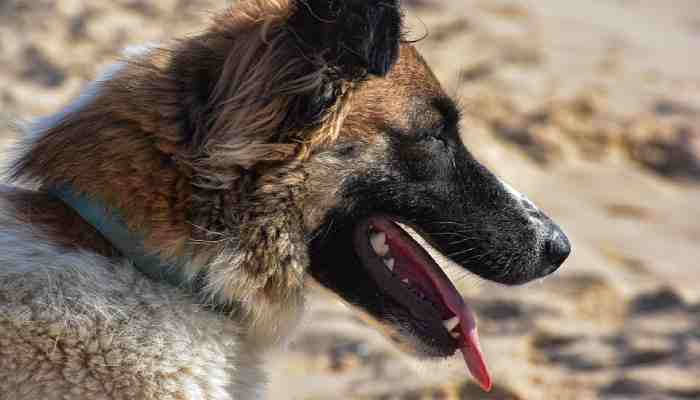Dental problems are a common issue in dogs and can range from minor issues such as bad breath to more serious problems such as tooth decay and periodontal disease. These problems can not only cause pain and discomfort for dogs, but can also lead to other health issues if left untreated.
Plaque and Tartar Buildup
These are very common dental issues that affect dogs of all ages and breeds. Plaque is a film of bacteria that forms on teeth and gums, and when it is not removed through regular brushing and professional cleanings, it can harden into tartar. Tartar is a hard, yellow or brown deposit that attaches to the teeth and gums, and it can lead to a variety of dental and oral health problems.
The first stage of plaque and tartar buildup is gingivitis. This is an inflammation of the gums caused by the buildup of bacteria in plaque. Symptoms of gingivitis include red, swollen gums that bleed easily and bad breath. If left untreated, gingivitis can progress to periodontal disease, which is a more serious condition that affects the tissues and structures that support the teeth. Symptoms of periodontal disease include receding gums, loose or missing teeth, and jaw bone loss.
There are several risk factors that can increase a dog’s likelihood of developing plaque and tartar buildup. These include genetics, poor dental hygiene, a diet high in sugar and carbohydrates, and certain medical conditions such as diabetes. Smaller breeds of dogs are also at a higher risk of developing plaque and tartar buildup due to the size of their teeth and mouths.
Prevention is the key to avoiding plaque and tartar buildup in dogs. Regular dental check-ups and professional cleanings are essential to keep your dog’s teeth and gums healthy. Daily brushing at home is also important, and it is recommended to use toothpaste and toothbrushes designed specifically for dogs. Additionally, a balanced and nutritious diet, providing appropriate chew toys and avoiding giving human food can also help maintain dental health in dogs.
Treatment for plaque and tartar buildup in dogs usually involves a professional cleaning under anesthesia. During this procedure, the vet will remove plaque and tartar from the teeth and gums, and may also perform other treatments such as polishing the teeth and applying a fluoride treatment. In advanced cases of periodontal disease, extractions may be necessary.
Tooth Decay
Tooth decay is another common dental problem in dogs that occurs when plaque and bacteria erode the enamel of the tooth, causing cavities. This can lead to pain, discomfort, and difficulty eating or chewing for dogs. If left untreated, tooth decay can also lead to more serious oral health problems such as infection and abscesses.
Risk factors for tooth decay in dogs include genetics, poor dental hygiene, a diet high in sugar and carbohydrates, and certain medical conditions such as diabetes. Smaller breeds of dogs are also at a higher risk of developing tooth decay due to the size of their teeth and mouths.
Symptoms of tooth decay in dogs can include sensitivity to cold or hot temperatures, visible holes or discolouration on the teeth, and difficulty eating or chewing. In advanced cases, dogs may also experience swelling, redness, and discharge from the affected area.
Prevention is the key to avoiding tooth decay in dogs. Regular dental check-ups and professional cleanings are essential to keep your dog’s teeth and gums healthy. Daily brushing at home is also important, and it is recommended to use toothpaste and toothbrushes designed specifically for dogs. Additionally, a balanced and nutritious diet, providing appropriate chew toys and avoiding giving human food can also help maintain dental health in dogs.
Treatment for tooth decay in dogs usually involves a professional cleaning under anesthesia. During this procedure, the vet will remove plaque and tartar from the teeth and gums, and may also perform other treatments such as polishing the teeth and applying a fluoride treatment. In advanced cases of tooth decay, extractions may be necessary.
Periodontal Disease
Periodontal disease, also known as gum disease, is a common oral health issue among dogs. It is caused by the buildup of plaque and tartar on the teeth and gums, leading to inflammation and infection. If left untreated, periodontal disease can cause severe damage to the teeth and gums, as well as to the bones supporting the teeth.
Symptoms of periodontal disease in dogs include bad breath, red or swollen gums, bleeding gums, and difficulty eating or chewing. In advanced stages, the disease can cause tooth loss and damage to the jawbone.
To prevent periodontal disease in dogs, it is important to establish a regular oral hygiene routine. This includes brushing the dog’s teeth regularly with a toothbrush and toothpaste specifically designed for dogs, as well as providing chew toys and bones that can help to scrape away plaque and tartar. Regular dental check-ups with a veterinarian is also important.
If your dog is already showing signs of periodontal disease, your veterinarian may recommend a professional cleaning under anesthesia. In advanced cases, dental surgery may be necessary to remove diseased teeth or repair damage to the jawbone.
Tooth fractures and Abscesses
Tooth fractures in dogs occur when a tooth cracks or breaks. This can happen due to trauma, such as running onto a wall or falling from a height, or from chewing on hard objects. Symptoms of a tooth fracture include pain, swelling, and bleeding from the affected area. In severe cases, the fractured tooth may need to be removed.
Abscesses, on the other hand, are pus-filled pockets that form in the tissues around a tooth. They can occur due to tooth decay, periodontal disease, or injury. Symptoms of an abscess include redness and swelling around the affected tooth, as well as pain and difficulty eating. If left untreated, an abscess can spread to other parts of the body and become life-threatening.
To prevent tooth fractures and abscesses in dogs, it’s important to practice good oral hygiene. This includes regular teeth brushing and providing your dog with appropriate chew toys to keep their teeth strong. Regular dental checkups with your veterinarian can also help detect any problems early on.
Prevention is the key to avoid dental problems in dogs. Regular dental check-ups and professional cleanings, as well as daily brushing, are essential to keep your dog’s teeth and gums healthy. A balanced and nutritious diet, providing appropriate chew toys and avoiding giving human food can also help maintain dental health in dogs.
In conclusion, dental problems are a common issue in dogs and can range from minor issues such as bad breath to more serious problems such as tooth decay and periodontal disease. These problems can not only cause pain and discomfort for dogs, but can also lead to other health issues if left untreated. Pet owners should be aware of the signs and symptoms of dental problems in dogs and take steps to maintain their dog’s dental health through regular check-ups, professional cleanings, daily brushing and a balanced diet.


